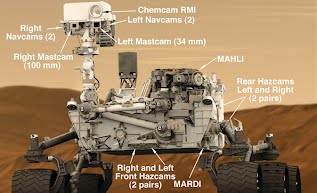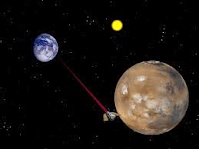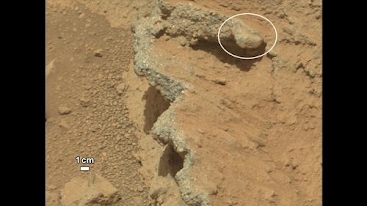by: Nicole Willett
As Curiosity roves the dry riverbed on Mars, she wonders about the geological history of the Red Planet. Of course Mars is a rocky planet that has silicates,basalt, and iron among many other mineral and rock compounds on its surface. The Curiosity Rover landed in Gale Crater because of its interesting geological features. One attractive feature is the alluvial fan (a deposit formed from a fast flowing stream as found on Earth) that appears to have at one time drained into the crater. The large mountain peak at the center of the crater, Aeolis Mons aka Mount Sharp, was also an appealing characteristic of Gale Crater. This enormous central peak rises above the surrounding rim. The layering of the strata is of particular interest to researchers. The rovers Sprit and Opportunity also discovered layered features on Mars, as well as many other interesting geological characteristics. Our fleet of spacecraft at Mars have discovered many things that were unexpected. However, some were inferred by scientists based on previous research. These features include craters, volcanoes, canyon systems, riverbeds, and caves.
Craters were expected to be found on the rocky surface of Mars, which they were. Large craters tend to be obvious and long lasting.  Smaller craters can be eroded by wind over long time periods and covered by Martian sand and dust. Victoria Crater is one of the most beautiful features on Mars. The Opportunity Rover spent approximately 2 Earth years (one Martian year) at the crater. The crater is large, 730 meters wide. Victoria Crater has scalloped edges with many alcoves and prominence’s. Endurance Crater was also visited by the Opportunity Rover for 180 sols (Martian days). This crater has very interesting layered sedimentary geology that was examined by Opportunity. The rover discovered there were differences in texture and sedimentary layering.This indicated that the lower layers were indeed older than the upper layers of rocks and soil.
Smaller craters can be eroded by wind over long time periods and covered by Martian sand and dust. Victoria Crater is one of the most beautiful features on Mars. The Opportunity Rover spent approximately 2 Earth years (one Martian year) at the crater. The crater is large, 730 meters wide. Victoria Crater has scalloped edges with many alcoves and prominence’s. Endurance Crater was also visited by the Opportunity Rover for 180 sols (Martian days). This crater has very interesting layered sedimentary geology that was examined by Opportunity. The rover discovered there were differences in texture and sedimentary layering.This indicated that the lower layers were indeed older than the upper layers of rocks and soil.
The volcanoes were photographed early in our exploration of Mars due to their sheer enormity. The most famous of all is Olympus Mons. This is the largest volcano in the solar system rising nearly 22km (14mi) above the Martian surface. Mount Everest is Earth’s tallest mountain, rising to a mere 29,029 ft
(8.85km or 5.5mi) above the surface. When comparing Olympus Mons to Mount Everest it is easy to see how Olympus Mons dwarfs Mount Everest. It has been said that Olympus Mons is so large that if you were standing on it, although it rises 14 miles in elevation, it would appear that you were standing on flat ground.
Rivers, outflow channels, and runoff channels have been speculated and discussed widely through the years. There are thousands of images that show what seem to be riverbeds all over Mars. We are now confirming unequivocally that these channels were once a place where water flowed freely across the surface of the planet for extended periods of time. The Curiosity Rover roved right into a riverbed within a few weeks of her mission. This is an incredible confirmation by NASA as well as another step forward in the search for life on the Red Planet.
 A more recent geological discovery is the caves on Mars. There is little known about the caves so far. NASA would like to send a rover or a spelunking robot to explore the caves. It is known that caves can go on for miles into the surface of a planet. The caves on Earth are home to thousands, if not, hundreds of thousands of organisms as well as ample amounts of water. We may find water in the caves on Mars. This is a fascinating discovery because they could potentially be used for habitats when humans arrive on the surface of Mars.
A more recent geological discovery is the caves on Mars. There is little known about the caves so far. NASA would like to send a rover or a spelunking robot to explore the caves. It is known that caves can go on for miles into the surface of a planet. The caves on Earth are home to thousands, if not, hundreds of thousands of organisms as well as ample amounts of water. We may find water in the caves on Mars. This is a fascinating discovery because they could potentially be used for habitats when humans arrive on the surface of Mars. 












